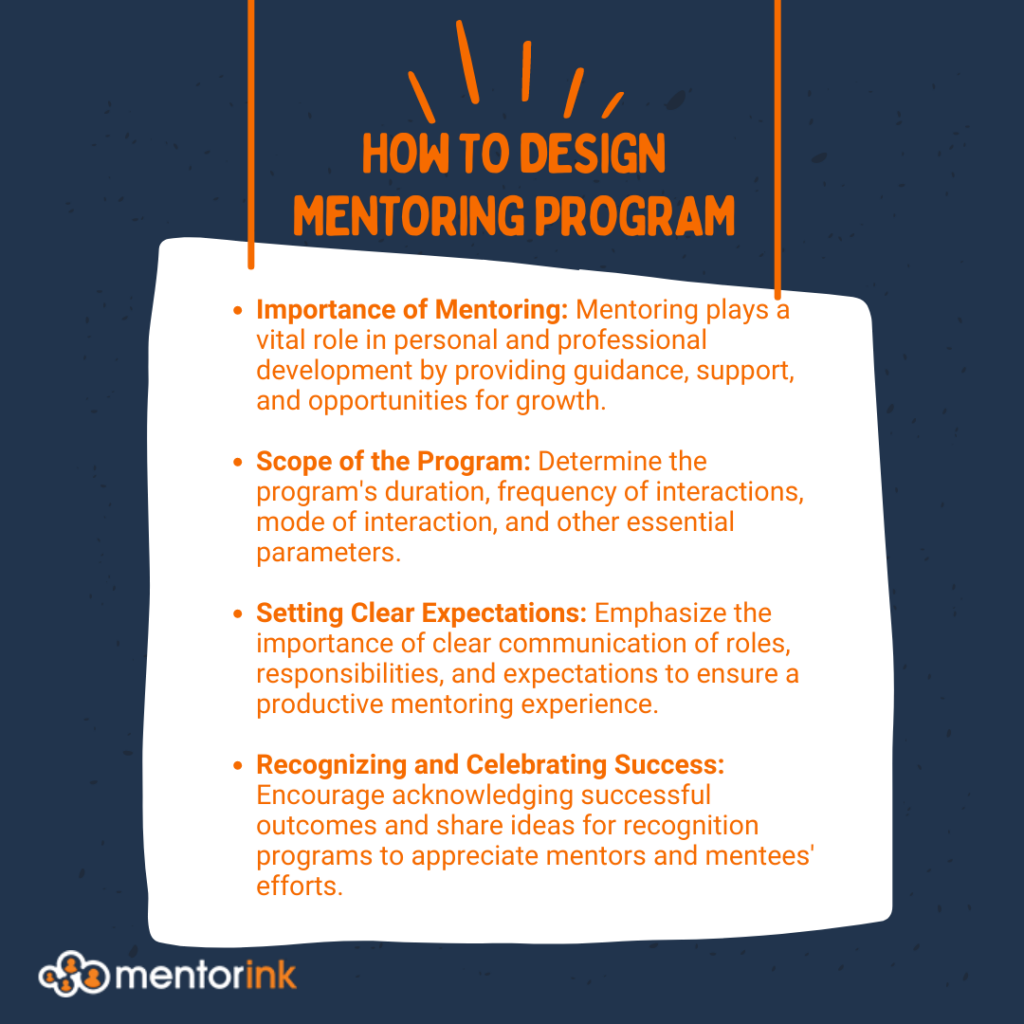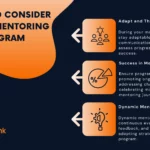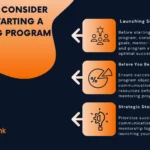
Designing a Mentoring Program for Professional Growth 💡
Mentoring plays a pivotal role in personal and professional development, offering valuable guidance, support, and opportunities for growth. To harness the power of mentoring and ensure its effectiveness, it is essential to design a well-structured mentoring program that aligns with specific objectives. The mentoring program should also meet the needs of both mentors and mentees.
In this guide, we’ll explore key strategies for a successful mentoring program that fosters growth.
Purpose of the article 📢
Mentoring programs are invaluable tools for personal and professional development, providing individuals with opportunities to learn, grow, and thrive. Whether implemented in educational institutions, workplaces, or community settings, a well-designed mentoring program can have a transformative impact.
This article aims to equip readers with the knowledge and insights needed to create effective mentoring programs. It will cover essential aspects such as defining program objectives, understanding different mentoring models, identifying mentoring needs, recruiting and training mentors, matching mentees with suitable mentors. Additionally, it will focus on establishing clear expectations, facilitating mentor-mentee relationships, monitoring progress, and celebrating success.
To summarize, this guide empowers readers to create a successful mentoring program where lasting connections are forged, potential is realized, and a brighter future is built
The specific goals and objectives of the mentoring program 🎯
The specific goals and objectives of a mentoring program may vary depending on the context and the target audience. Here are some common goals and objectives that mentoring programs often aim to achieve:
- Skills Development: Enhancing mentees’ knowledge and skills in specific areas, such as technical expertise, leadership, communication, problem-solving, or industry-specific skills.
- Career Advancement: Assisting mentees in setting and achieving career-related goals, such as promotions, career transitions, or professional development opportunities.
- Knowledge Transfer: Facilitating the transfer of knowledge and expertise from experienced mentors to less-experienced mentees.
- Confidence Building: Boosting mentees’ confidence and self-esteem, empowering them to take on new challenges and responsibilities.
- Networking and Relationship Building: Providing mentees with opportunities to expand their professional networks and build valuable connections within their industry or community.
- Personal Growth and Development: Supporting mentees in achieving personal growth, self-awareness, and work-life balance.
- Diversity and Inclusion: Promoting diversity and inclusion by offering mentoring opportunities to individuals from underrepresented groups.
- Retention and Engagement: Improving employee or student retention and engagement by providing mentorship and support.
- Cultural and Organizational Integration: Assisting newcomers in adapting to a new culture or organizational environment.
- Community Engagement: Encouraging community members to engage in mentoring relationships to support one another’s growth.
To summarize, It is essential for a mentoring program to have clear, well-defined goals and objectives. This ensures that it meets the needs of both mentors and mentees effectively. Therefore The goals should be aligned with the program’s overarching vision and should be communicated to participants at the outset. This helps set clear expectations and foster successful mentoring relationships.
Target audience for the program 🏘
The target audience for a mentoring program depends on the specific objectives and focus of the program. Here are some examples of different target audiences for mentoring programs:
- Employees: Mentoring programs in workplaces target employees at various levels within the organization. These programs may focus on leadership development, career advancement, onboarding support for new hires, or enhancing specific job-related skills.
- Students: Mentoring programs in educational institutions support students’ academic and personal growth. Mentors may guide students in their studies, career choices, extracurricular activities, and overall personal development.
- Entrepreneurs: Mentoring programs for entrepreneurs aim to assist startup founders or aspiring business owners. Mentors in this context can provide guidance on business strategy, networking, funding opportunities, and overcoming common challenges faced by entrepreneurs.
- Young Professionals: Some mentoring programs focus on helping young professionals who have recently entered the workforce. These programs may provide career guidance, soft skill development, and support in navigating the early stages of their careers.
- Underrepresented Groups: Mentoring programs may specifically target individuals from underrepresented or marginalized groups. These programs aim to provide additional support and opportunities to help address diversity and inclusion issues.
- Community Members: Some mentoring programs are open to the broader community, where individuals from various backgrounds can participate as mentors or mentees.
- Career Changers: Mentors can offer insights and guidance to facilitate a smooth transition into the new career path.
- Graduates and Alumni: Mentoring programs connect recent graduates with experienced alumni mentors to ease the transition to the professional world.
Therefore it’s important for the mentoring program organizers to clearly define the target audience based on the program’s goals and objectives. By tailoring the program to the specific needs and interests of the target audience, the mentoring experience can be more relevant, impactful, and rewarding for both mentors and mentees.
The scope of the program 🌐
Here are some key aspects to consider when determining the scope of the mentoring program:
- Duration: Decide on the overall duration of the program, which can range from a few months to a year or longer. This decision depends on the program’s objectives and the depth of mentoring relationships desired. Short-term programs may focus on specific skill development, while long-term programs can foster more profound personal and professional growth.
- Frequency of Interactions: Determine how often mentors and mentees will interact. This can vary based on the program’s intensity and goals. Interactions could take place weekly, bi-weekly, or monthly, depending on the availability of participants and the level of support required.
- Mode of Interaction: Consider whether mentoring interactions will be conducted in person, virtually (through video conferencing or online platforms), or a combination of both. Virtual mentoring can offer flexibility and accessibility, particularly for participants in different locations.
- Group Size: Decide whether the program will involve one-on-one mentoring relationships or if there will be group mentoring sessions.
- Program Resources and Support: Determine the resources available to support mentors and mentees throughout the program.
- Mentor-Mentee Matching: Define the process for matching mentors with mentees. Consider factors such as expertise, interests, and personalities to create compatible and productive mentoring pairs.
- Program Guidelines and Expectations: Set clear guidelines and expectations for both mentors and mentees. Define the roles and responsibilities of participants to ensure that everyone understands their commitment to the program.
- Monitoring and Evaluation: Decide how the program’s progress and effectiveness will be monitored and evaluated. Regular feedback from mentors and mentees can help identify areas for improvement and measure the program’s impact.
Hence, by carefully defining the scope of the mentoring program, organizers can create a meaningful and enriching experience for all participants. This can lead to successful outcomes and long-lasting connections.
Understanding Mentoring Models: Mentoring Models ☺︎
Mentoring models vary in structure and dynamics, catering to different needs and preferences of participants. Here are three common mentoring models:
One-on-One Mentoring
- Benefits:
- Personalized Guidance: One-on-one mentoring offers personalized attention and guidance tailored to the mentee’s unique needs and goals.
- Trust and Confidentiality: The exclusive nature fosters trust and confidentiality, allowing mentees to openly discuss challenges.
- Mentor’s Full Attention: The mentor’s undivided attention leads to more in-depth discussions and insights.
- Limitations:
- Resource-Intensive: One-on-one mentoring can be resource-intensive for organizations, as it requires matching individual mentors with specific mentees and managing multiple mentoring relationships.
- Limited Peer Interaction: Mentees in one-on-one mentoring might miss out on the diverse perspectives and support that come from interacting with peers in a group setting.
Group Mentoring
- Benefits:
- Diverse Perspectives: Group mentoring exposes mentees to a diverse range of experiences, ideas, and perspectives from multiple participants.
- Peer Learning: Participants learn from each other’s challenges and successes, fostering a supportive and collaborative learning environment.
- Time-Efficient for Mentors: Mentors can reach and support multiple mentees simultaneously, making efficient use of their time and expertise.
- Limitations:
- Less Personalized Attention: In group mentoring, the mentor’s attention may be divided among multiple mentees, which might lead to less individualized guidance.
- Group Dynamics: Group mentoring success relies on effective group dynamics.
Reverse Mentoring
- Benefits:
- Intergenerational Learning: Reverse mentoring promotes knowledge exchange between generations.
- Enhanced Employee Engagement: Reverse mentoring boosts engagement by empowering junior employees to actively contribute to the organization’s growth.
- Breaking Hierarchies: This model breaks down hierarchical barriers, fostering a culture of open communication and mutual respect.
- Restriction:
- Organizational Acceptance: Some organizations might be hesitant to adopt reverse mentoring due to traditional hierarchical structures or skepticism about junior employees mentoring senior ones.
- Relevance of Topics: The success of reverse mentoring depends on selecting relevant and valuable topics for both the mentor and mentee.
To summarize, the most suitable mentoring model depends on program objectives, available resources, and mentor-mentee preferences.
Identifying Mentoring Needs 📩
Here are the key steps to conduct a needs assessment:
- Clarify Program Objectives: Start by defining the overall objectives of the mentoring program. Understanding the program’s purpose will guide the needs assessment process and ensure that it aligns with the program’s goals.
- Create Surveys or Questionnaires: Develop surveys or questionnaires for both potential mentees and mentors.
- Interviews or Focus Groups: Consider conducting interviews or focus groups with a representative sample of potential mentees and mentors.
- Identify Skill Gaps and Development Areas: Assess the current skills and knowledge of potential mentees and mentors to identify any skill gaps or areas for improvement that could be addressed through mentoring.
- Consider Personal and Professional Goals: Understand the personal and professional goals of mentees and mentors to ensure that the mentoring relationships are aligned with their individual aspirations.
- Evaluate Organizational or Institutional Needs: If the mentoring program is implemented within an organization or institution, consider the broader goals and needs of the organization.
- Assess Demographic and Diversity Considerations: Consider the demographic characteristics of potential mentees and mentors, including age, gender, race, ethnicity, and experience levels. Ensure that the program promotes diversity and inclusion.
- Analyze Feedback and Data: Analyze the collected data to identify common themes, patterns, and areas of consensus among potential mentees and mentors.
- Identify Overlapping Needs: Identify overlapping needs for mutually beneficial mentoring relationships.
- Continuous Feedback Loop: Implement a continuous feedback loop throughout the mentoring program. Assess its effectiveness and make necessary adjustments based on feedback from mentees and mentors.
A thorough needs assessment ensures a well-targeted mentoring program meeting expectations of both mentees and mentors. It also enhances the likelihood of creating meaningful and successful mentoring relationships. These relationships contribute to the personal and professional growth of all participants.
Selecting and Matching Mentees 🖱️
The mentee selection process involves multiple steps to choose the right participants. Here’s an outline of the process:
- Define Program Objectives: Start by defining program objectives, outcomes, and areas of development.
- Identify Eligibility Criteria: Determine eligibility criteria for mentees based on program goals and audience. Consider job roles, experience levels, and relevant factors.
- Open Application or Nomination: Open application process to mentees or allow nominations from supervisors, HR, or colleagues. Use online forms or designated application portals.
- Application or Self-Assessment: Request interested individuals to complete an application form, providing background, aspirations, and interests. Inquire about their goals for the mentoring experience.
- Screening and Interviewing: Review applications to check eligibility. Conduct interviews with shortlisted candidates, assessing commitment, willingness to learn, and alignment with program goals.
- Diversity and Inclusion: Aim for diversity and inclusion in the selection process to create a well-rounded and representative cohort of mentees. Consider factors such as gender, race, ethnicity, and other demographic characteristics to ensure equitable participation.
- Matching Mentees with Mentors: Based on the information gathered from the applications and interviews, carefully match mentees with suitable mentors.
- Communication and Notification: Inform accepted mentees about program details, including the mentoring schedule and pre-program orientation.
- Feedback and Appeals: Seek mentee feedback on the matching process. Consider appeals and adjustments if needed.
- Waitlist and Future Opportunities: If mentees exceed mentor capacity, create a waitlist or offer future mentoring opportunities to others.
- Orientation and Expectations: Conduct an orientation session for selected mentees to set clear expectations and review program guidelines.
Thus, ensure a transparent selection process, respecting confidentiality of personal information. A well-structured process attracts diverse and committed mentees eager for growth.
Setting Clear Expectations 💘
Setting clear expectations is fundamental to the success of a mentoring relationship and the overall mentoring program. Here’s why it’s crucial:
- Alignment of Goals: Clear communication of roles and expectations ensures that both mentors and mentees are on the same page regarding their objectives for the mentoring relationship. This alignment increases the likelihood of achieving meaningful outcomes.
- Efficient Use of Time: When mentors and mentees understand their respective responsibilities, they can use their time effectively and focus on activities that contribute to their growth and development.
- Mutual Accountability: Clearly defined roles and expectations create a sense of mutual accountability. Both mentors and mentees feel responsible for their commitments and are more likely to actively engage in the mentoring process.
- Reduces Misunderstandings: Ambiguity in roles and expectations can lead to misunderstandings or unmet needs. Clear communication minimizes the chances of miscommunication and promotes a positive mentoring experience.
- Empowerment and Autonomy: When both parties know what is expected of them, they feel empowered to take ownership of their learning and mentoring journey.
- Consistency in Experience: Setting clear expectations ensures consistency in the mentoring experience for all participants, promoting fairness and equity.
To summarize, by emphasizing clear communication of roles and expectations and providing guidance on establishing achievable goals and milestones, the mentoring relationship becomes more purposeful and effective. Both mentors and mentees can collaboratively work toward meaningful outcomes and experience the full benefits of a well-structured mentoring program.
Monitoring and Evaluating Progress 📊
Monitoring the mentoring relationships and assessing the program’s effectiveness are crucial components of a successful mentoring initiative. Here’s why they are important:
- Ensuring Progress and Impact: Monitoring mentoring relationships allows organizers to track progress and ensure that both mentors and mentees are actively engaged and making meaningful strides toward their goals.
- Identifying Challenges and Barriers: Regular monitoring helps identify any challenges or barriers faced by mentors and mentees. Addressing these issues promptly can enhance the overall mentoring experience and lead to better outcomes.
- Opportunity for Course Correction: By monitoring the program’s progress, organizers can make data-driven decisions and implement course corrections if the program is not yielding the expected results.
- Enhancing Accountability: Regular monitoring fosters a sense of accountability among mentors and mentees. Knowing that their progress is being monitored motivates them to stay committed to the mentoring relationship.
- Identifying Success Factors: Evaluating the program’s effectiveness allows organizers to identify successful mentoring practices and replicate them in future iterations of the program.
- Continuous Improvement: Monitoring and evaluation provide valuable insights that can be used to improve the mentoring program in subsequent cycles. It ensures that the program evolves and remains relevant to the needs of participants.
- Stakeholder Satisfaction: Assessing the program’s impact and outcomes helps demonstrate the value of the mentoring program to stakeholders, such as organizational leadership, donors, or program sponsors.
To summarize, by actively seeking feedback from mentors and mentees through various methods, program organizers can gain valuable insights to improve the mentoring program’s design, processes, and outcomes. Continuous improvement based on feedback ensures that the program remains effective, relevant, and impactful for all participants.
Recognizing and Celebrating Success 🎉
Recognizing and celebrating successful mentoring outcomes is essential to foster a positive mentoring culture and motivate mentors and mentees to continue their valuable efforts. Here’s why it’s important:
- Motivation and Encouragement: Recognizing successful outcomes provides positive reinforcement to mentors and mentees, encouraging them to continue investing their time and effort in the mentoring relationship.
- Peer Learning and Inspiration: Celebrating success allows mentors and mentees to share their achievements with others, inspiring and motivating their peers to excel in their own mentoring journeys.
- Organizational Support: Publicly acknowledging mentoring successes signals to the organization that mentoring is valued and supported, which can lead to increased organizational commitment to the program.
- Building a Mentoring Culture: By celebrating successful outcomes, organizations can cultivate a mentoring culture where mentorship is seen as a valuable tool for personal and professional growth.
- Retention and Engagement: Recognizing and celebrating success contributes to the mentees’ sense of accomplishment and belonging, leading to increased retention and engagement with the organization or program.
Thus, remember that recognition and celebration should be meaningful and sincere. The goal is to show genuine appreciation for the efforts of mentors and mentees, fostering a positive and supportive mentoring environment. Thus by implementing recognition programs or events, organizations can reinforce the value of mentoring and inspire participants to continue their mentoring journey with enthusiasm and dedication.
Conclusion
The article explored the topic of “How to Design a Mentoring Program” and provided a comprehensive guide for creating successful mentoring initiatives. The key points covered are as follows:
- Importance of Mentoring: Mentoring plays a vital role in personal and professional development by providing guidance, support, and opportunities for growth.
- Purpose of the Article: The article aimed to provide a comprehensive guide on designing a mentoring program to meet specific objectives.
- Goals and Objectives: Clearly define the goals and objectives of the mentoring program to guide the program’s design and outcomes.
- Target Audience: Identify the specific target audience for the program, such as employees, students, entrepreneurs, or other groups.
- Scope of the Program: Determine the program’s duration, frequency of interactions, mode of interaction, and other essential parameters.
- Mentoring Models: Explore various mentoring models, including one-on-one, group mentoring, and reverse mentoring, to suit different needs and preferences.
- Matching Mentors and Mentees: Outline strategies for effectively matching mentors and mentees based on their goals and preferences to create meaningful relationships.
- Setting Clear Expectations: Emphasize the importance of clear communication of roles, responsibilities, and expectations to ensure a productive mentoring experience.
- Monitoring and Evaluating Progress: Highlight the need for monitoring mentoring relationships and assessing program effectiveness to continuously improve the program.
- Recognizing and Celebrating Success: Encourage acknowledging successful outcomes and share ideas for recognition programs to appreciate mentors and mentees’ efforts.
In conclusion, well-designed mentoring programs are powerful tools for personal and professional growth, benefiting individuals and organizations alike. By following the guidelines and strategies outlined in this article, mentoring program organizers can create impactful and rewarding mentoring experiences. These experiences empower mentees, support mentors, and contribute to a thriving and successful community.
Sounds exciting?
We would be very happy to support your design and run your mentoring programs
Book your Demo

